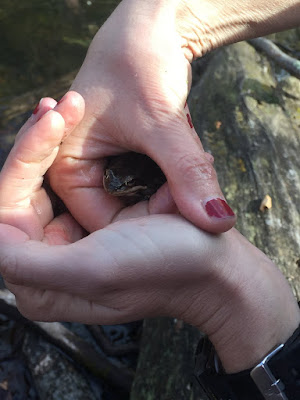My collections areas include all waterways of the Preserve, Louisa Pond, and Humpo Marsh. It's a good thing I purchased my own waders last summer, because right now, the creatures are scarce. It's still pretty much in winter-mode still and many of the creatures are deeper in the water. And...I am pretty glad I purchased the neoprene waders. Kathy, my Director of Education, urged me not to get those. But since I am collecting not just in the fall when it is still relatively warm, I am collecting in winter, and they keep me nice and toasty!! I'm a smart cookie for thinking that one up! Just kidding!
I think one of my favorite parts of the job is definitely being out in the field - with students, with research associates, other staff, or even just myself. I think every time I am out of the land, I end up finding something special. This morning while I was out, I scooped up some Spotted Salamander eggs (do not worry, I placed them back!) and two large Giant Water Bugs (these will be great for a Creature Feature or special guest when I come to the classrooms). Check out the pics below!
TheChristyBel
Spotted Salamander
Looks Like: Spotted Salamanders have stout, black to dark-brown bodies, a broadly rounded snout, large and strong legs with four to five toes on each foot. The underbelly is a pale, slate gray, the mid-dorsal lines of the body have up to 24 to 45 large, round, yellow or orange spots in two irregular rows running from head to tail.
 |
| Spotted Salamander Eggs |
Niche: Adult Spotted Salamanders are rarely seen since they spend most of their time hiding in leaf litter, under decomposing logs, or in tunnels below ground. These animals may help with control of insect pests such as mosquitoes that breed in their vernal pools or ponds.
Threats: In dry spring times, many young Spotted Salamanders in temporary vernal pools can die before they mature enough to leave the pool before it dries up. As their pond dries and the water level declines they also become more vulnerable to predators. With climate change, the wide fluctuation in the occurrence and amount of precipitation during spring and summer and lack of snow cover in winter can pose major risks for Spotted Salamander's survival. Acidic rain at breeding time can cause embryonic mortality. Loss of small unregulated wetlands is also a major threat.
Frequency: The Spotted Salamander is a fairly common species on the forest floor. They can serve as prey for skunks, raccoons, turtles, and snakes. Their eggs are also prey for frog tadpoles, crayfish, and other macroinvertebrates. Red-spotted Newts have been seen feeding on the egg mass jelly.
Reproduction: During the spring breeding season, adults migrate to ponds and vernal pools to lay their eggs in fish-free, fresh water (usually starting their migration during the first foggy rain during the thaw of snow). Males produce blobs of sperm (spermatophores) allowing the female to take the spermatophores into her body to fertilize her eggs. Females will lay compact firm egg masses that are attached to submerged objects. A female can lay between 100-300 eggs per year. The eggs are encased in a protective thick, clear, or milky jelly. Spotted Salamander larvae are a dull, greenish color when hatched.
Fun Fact: Spotted Salamanders have poison glands in their skin located on their backs and tails. When the salamander is in danger or threatened, their glands release a sticky, white, toxic liquid.
 |
| Large Giant Water Bugs Also known as "Toe-Biters." They definitely pack one painful pinch! |

























